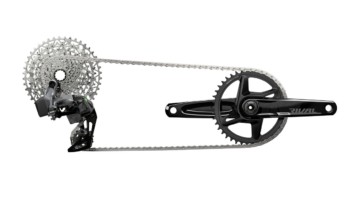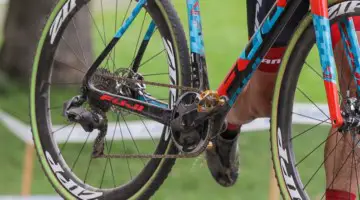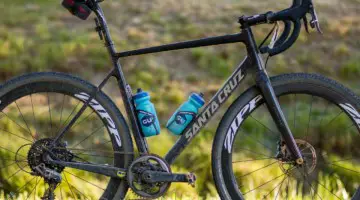SRAM Force CX1 X-SYNC Chainrings: Mud Recesses, 10 or 11-speed Compatible
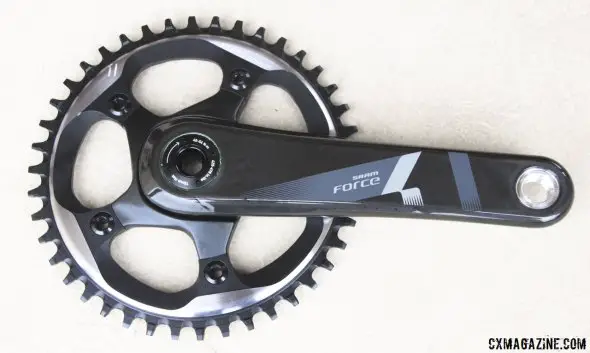
SRAM’s new Force CX1 single chainring cyclocross drivetrain uses a SRAM Force carbon crankset with X-SYNC chainrings in the outer ring position. © Cyclocross Magazine
The Force CX1 chainrings adopt the X-SYNC wide/narrow chainring technology found on the XX1 mountain bike drivetrains, and adds larger sizes with 38 to 46 tooth options, in two tooth increments. While JP McCarthy, SRAM’s Force CX1 Product Manager, did most of his initial testing using actual XX1 38t chainrings, the production CX1 chainrings’ teeth profiles have been modified specifically for cyclocross use, with small cutouts for better mud shedding.
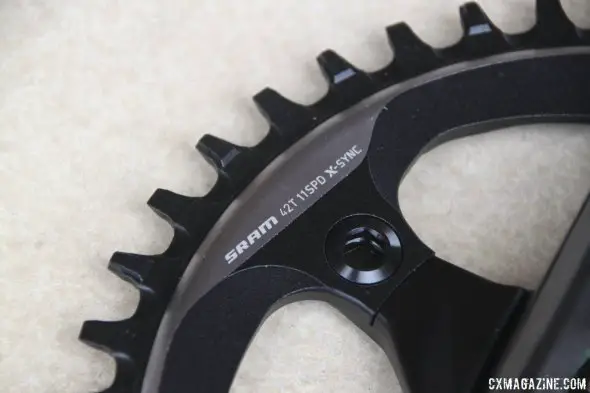
SRAM’s new Force CX1 X-SYNC chainring’s wide teeth have cutaways below where the chain sits for better mud clearance than the MTB rings. The rings are marked 11-speed, but will work with 10-speed chains according to SRAM. © Cyclocross Magazine
The rings come drilled in a 110mm BCD pattern, and come with the hidden bolt nut specifically for the SRAM Red 22 and Force 22 crankset hidden bolt pattern—removing the hidden bolt nut from the ring will allow you to use them on other 110mm BCD cranksets.
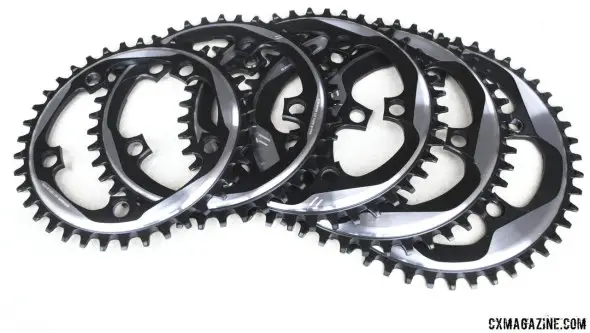
SRAM’s new Force CX1 chainrings are available in 38,40, 42, 44, and 46t increments and will work with standard 110mm BCDs and SRAM’s hidden bolt cranksets. © Cyclocross Magazine
The Force CX1 chainrings will come in five sizes from 38 to 46 teeth, and future plans may include other sizes like a 36. The rings are designed to be run in the big chainring position, but the teeth actually sit a bit inboard of where an outer ring’s teeth would sit, for better chainline. Original prototype setups had the rings on the inner ring position, but extensive testing found that the larger sizes (44 and 46t) would hit the chainstays on some frames.
The CX1 rings will work with both 10-speed and 11-speed SRAM chains, meaning if you already have 10-speed DoubleTap shifters, you can still use them. “Inner dimensions of the 10-speed and 11-speed chains are not the same, but they’re close,” explains McCarthy on why the chainrings should work with either chain. The external dimensions differ more than the internal dimensions between 10-speed and 11-speed chains, and matter for rear shifting.
Elle Anderson raced a 42t ring paired with an 11-32t cassette for much of the 2013/2014 cyclocross season, while Tim Johnson typically used a 44t ring in the front. McCarthy expects most amateurs to be happy with a 38t or 40t chainring, paired with an 1170 11-32t cassette. Other cassette options are the 1170 11-26t and 11-28t cassettes, and SRAM told Cyclocross Magazine that they’re working on a new 11-30t option.
On our first ride, we used a 42t chainring paired with an 11-32t cassette, and followed a bunch of mountain bikers up and down trails and some big hills in Southern California. While the 42x32t gearing was far taller than any of our ride companions’ gearing, it was surprisingly versatile and certainly didn’t slow us down, and should prove to be plenty wide enough for the average cyclocross course or mixed terrain ride. We’d probably opt for a 40t for more versatility and bigger adventures in the off-season, but for racing, the 42t felt just fine. And when chasing mountain bikers, being over-geared has some advantages.
GXP crank arms will be $148, while BB30 arms will be $182. Chainrings will retail from $126-$152 depending on the size.
The Force CX1 X-SYNC chainring is just one of two necessary CX1 components. Read on to learn about what makes the CX1 Type 2 rear derailleur unique.
























